Benefits of eLearning Content Development and Finding Your Ideal Company
What is eLearning Content Development?
eLearning content development is the process of creating interactive educational materials for online learning, such as:
1. eLearning Courses
2. Training Resources
It encompasses planning, design, and production to enhance online learning experiences.
Why is eLearning Content Development Important?
eLearning content development plays a crucial role in ensuring learning continuity, such as:
1. Boosting business productivity.
2. Delivering time-efficient training.
3. Improving overall employee performance.
It provides the flexibility to learn anytime, anywhere, which is essential in today’s fast-paced work environment.
The COVID-19 pandemic has accelerated the adoption of eLearning for remote quality learning.
Qualities of a Top eLearning Content Development Company
1. Expertise in instructional design and pedagogy.
2. Technological proficiency and innovation in content delivery.
3. Customization capabilities to meet specific organizational needs.
4. Proven track record and client testimonials.

Benefits of Effective eLearning Content Development
Effective eLearning content development services brings numerous benefits to
1. Businesses
2. Industries
3. Employees.
Some key advantages of eLearning Content Development include:
1. Convenience and adaptability
Learners can access training materials at their own pace and convenience, fitting learning into their busy schedules.
2. Budget-friendly
eLearning eliminates the need for expensive in-person training sessions, reducing costs associated with travel, venue rental, and instructor fees.
3. Catering to a variety of learning styles
Online training modules can be designed to accommodate different learning preferences, including visual, auditory, and kinesthetic.
4. Self-directed and self-paced
Learners have control over their learning journey, enabling them to focus on specific topics or revisit content as needed.
5. Measurable outcomes
eLearning platforms often provide tracking and assessment tools, allowing organizations to measure the effectiveness of training and monitor learner progress.
6. Interactivity and gamification
Engaging elements such as quizzes, interactive activities, and gamification techniques make the learning experience more enjoyable and effective.
7. Availability of experts
eLearning platforms can bring subject matter experts from around the world, providing learners with access to a wide range of expertise and perspectives.
8. Collaboration and community development
Virtual training modules can foster collaboration among learners through discussion forums, group projects, and social learning features.
9. Immediate feedback and acknowledgement
Learners receive instant feedback on their progress, enabling them to identify areas for improvement and celebrate their achievements.
10. Connectivity and standardization on a large scale
eLearning allows organizations to deliver consistent training content to a geographically dispersed workforce, ensuring uniformity in knowledge and skills.
11. Offers personalization
Online training modules can be tailored to individual learners’ needs, providing personalized learning paths and content recommendations.
12. Saves time and efforts
eLearning eliminates the need for travel and reduces time spent away from work, making training more efficient and cost-effective.
13. Better knowledge retention
Interactive and engaging eLearning content promotes better retention of information and enhances long-term knowledge retention.
14. Reduces learning time
Learners can progress through the material at their own pace, potentially reducing the time required for training compared to traditional classroom-based methods.
15. Just-in-time accessibility
Online training modules allow learners to access information and resources when needed, providing on-demand learning opportunities.
16. Flexible and scalable
eLearning can easily accommodate a growing number of learners, making it scalable for organizations of all sizes.
17. Better productivity
Well-designed eLearning content can lead to improved employee performance, productivity, and job satisfaction.
18. Higher ROI
Organizations can achieve a higher return on investment (ROI) by reducing training costs and improving the effectiveness of learning outcomes
Are you looking for the best eLearning content development company?
Key Considerations When Choosing an eLearning Content Development Company
Step 1: Define the Scope of your eLearning project
1. Clearly identify the goals, target audience, and desired outcomes of your eLearning initiative.
2. Determine the specific topics or skills that need to be addressed through the training modules.
Step 2: Research your Target Audience
1. Understand the characteristics, preferences, and learning styles of your target audience.
2. Conduct surveys or interviews to gather insights and tailor the content accordingly.
Step 3: Mind Mapping
1. Use mind mapping techniques to visualize the structure and flow of your eLearning content.
2. This helps in organizing ideas, identifying connections, and creating a coherent learning experience.
Step 4: Formulating SMART Learning Objectives
1. Set specific, measurable, achievable, relevant, and time-bound (SMART) learning objectives for each module.
2. Clearly define what learners should be able to achieve after completing the training.
Step 5: Creating a Clear Design Strategy
1. Develop a design strategy that aligns with your learning objectives and engages learners.
2. Consider the use of multimedia elements, interactive activities, and engaging visuals to enhance the learning experience.
Step 6: Storyboarding
What is Storyboard?
A storyboard is a visual plan or outline that maps out the content, interactions, and visual elements in sequential order, providing a guide for the development of online learning material.
1. Create a storyboard that outlines the content, visuals, and interactions for each module.
2. This serves as a blueprint for the development phase and ensures consistency and coherence throughout the course.
Here is the instructional design strategy and the adult learning principles used to craft storyboards based on the received inputs:
1. Presenting content in a self-explanatory manner through meaningful graphics, animations, and other visual elements.
2. Ensuring learner motivation with simple content and elegant graphic designs.
3. Arousing learner curiosity using a question-based approach.
4. Ensuring learner engagement through meaningful click-to-reveal interactions, practice exercises (formative assessments), and addressing the learner in the first person using ‘you.’
5. Enhancing learner experience and knowledge with pre-assessments, icebreakers, and training introductions.
6. Ensuring learning retention through immediate practice activities focused on important concepts.
7. Incorporating a gamification approach with available motivation and rewards to boost learner efficiency.
8. Adopting a problem-solving approach by creating a scenario-based storytelling learning experience for the course content.
9. Developing virtual simulations based on the content, including software simulations like watch-try-do methods to provide practical learning experiences.
Step 7: Choosing the Right Authoring Tools
Select suitable authoring tools or eLearning platforms that align with your requirements. Consider factors such as
1. Ease of use elearning authoring Tools
2. Interactivity options
3. Multimedia support
4. Compatibility with your learning management system (LMS)
Here are the top Softwares/tools eLearning content development:
1. Articulate Storyline 360
2. Articulate Rise 360
3. Adobe Captivate
4. Lectora
5. Elucidat
6. iSpring Suite
7. Animaker
Step 8: Developing your Online Course
Utilize the chosen authoring tools to develop the eLearning content. Incorporate multimedia elements, interactive assessments, and engaging scenarios to create an immersive learning experience.
ADDIE Model Methodology for eLearning Content Development
What is the ADDIE model?
ADDIE model is an acronym for a structured instructional design framework consisting of Analysis, Design, Development, Implementation, and Evaluation stages.
The ADDIE model, a methodology for content development, proves to be efficient, versatile, and well-suited for the demands of online or web-based training (WBT).
One of its advantages lies in its ability to rectify errors from previous iterations, thereby enhancing the overall quality of the product.
Representing the five stages of eLearning courseware development, ADDIE ensures that each stage produces a deliverable that informs the subsequent stage.
This structured approach is an excellent method for creating effective online courses with measurable learning objectives.
Step 9: Making it Interactive
1. Integrate interactive elements such as quizzes, simulations, branching scenarios, and gamification techniques to keep learners actively engaged.
2. Encourage learner participation and decision-making to enhance knowledge retention.
Step 10: Quality Assurance and Quality Testing
1. Review thoroughly and test the eLearning modules for functionality, usability, and accuracy.
2. Ensure that the content is error-free, the navigation is intuitive, and the overall user experience is seamless.
Step 11: LMS Hosting
Choose a reliable learning management system (LMS) to host and deliver your eLearning content.
The LMS should provide features for tracking learner progress, generating reports, and facilitating seamless access to the training modules
With the above-mentioned steps, you can effectively create engaging and exciting virtual training modules for your intended learners.
However, navigating the complexities of eLearning content development can be challenging and time-consuming.
About Us
At Swift eLearning services, we specialize in creating customized eLearning solutions that cater to your specific training needs.
With over a decade of experience in eLearning, we have developed more than 10,000+ hours of eLearning content for various industries and training requirements.
How Can We Help You?
Swift eLearning services can assist you in designing personalized eLearning solutions that align with your business goals and performance standards.
Our team of professionals is adept at creating interactive, informative, and engaging eLearning modules that focus on improving skills, behavior, and overall performance at work. For industries such as:
1. Pharmaceutical,
2. Retail,
3. Manufacturing,
4. Healthcare,
5. Educational institutions,
6. Banking & finance, and many others,
We have the expertise to create innovative, customized, and result-oriented eLearning solutions.
Our Core Expertise Lies In eLearning Content Creation
eLearning Content Development
We specialize in creating fully interactive and engaging online modules that streamline complex learning. Our expertise extends to designing, developing, and delivering over 10,000+ hours of custom eLearning content.
Read More >
Translation and Localization
Our eLearning Translation and Localization services ensure comprehensive learning experiences for your global workforce. We have a competent and experienced multilingual team that can translate your eLearning courses into over 35+ languages, while also providing excellent localization that takes into account cultural differences and other factors.
Read More >
Conversion of Classroom Training Content
With our extensive experience, we can convert your existing training content, such as PowerPoint presentations, facilitator guides, or instructor-led training materials, into responsive, engaging, and high-quality virtual training modules.
Read More >
Blended Learning Solutions
We adopt relevant and effective blended learning models to provide learners with a comprehensive and flexible learning experience. By combining instructor-led training with responsive eLearning, we reinforce knowledge retention and ensure a more holistic learning journey.
Read More >
Mobile Learning
Our mobile learning services enable learners to access training and performance support anytime and anywhere, on a variety of modern mobile devices and gadgets.
Read More >
Flash to HTML5 Conversion
We refurbish and upgrade your legacy Flash courses, ensuring future-proof compatibility. Using our 4R strategies (Record, Republish, Rebuild, and Redesign), we transform your outdated courses into HTML5 for seamless mobile compatibility.
Read More >
Learning Management System
Our online learning management system is comprehensive, configurable, reliable, secure, and user-friendly. It empowers you to design, manage, and sell training courses effectively.
Read More >
Why Choose Us?
Swift eLearning is committed to addressing all your learning and training challenges while aligning with your company goals.
With a wealth of experience and a dedicated team, we deliver high-quality and nnovative digital learning services in a time-efficient and cost-effective manner.
What sets us apart is our holistic approach to instructional design methodologies, ensuring that we elevate your learning experiences to the next level.
By partnering with Swift eLearning, you can become future-ready in the competitive and high-tech eLearning world.
Our experienced, skilled, and professional team is equipped to deliver personalized solutions that meet your unique training requirements and drive exceptional business results.
Ready to transform your learning experience and drive success in your industry?
Contact us today to explore the possibilities and revolutionize your approach to eLearning! Your journey towards enhanced performance starts here.
Conclusion
In today’s competitive learning landscape, eLearning content development plays a vital role in delivering engaging and effective online training modules.
The ADDIE model provides a structured and flexible approach to create high-quality eLearning content that aligns with your learning objectives.
By understanding the importance and benefits of effective eLearning content development, you can leverage its advantages to enhance learning continuity, improve business productivity, and boost overall employee performance.
Remember to follow the key steps in the development process, from defining the scope to hosting the modules on a reliable LMS.
Frequently Asked Questions
How long does it take to develop an eLearning module?
The development timeline for an eLearning module depends on various factors, including the complexity of the content, the level of interactivity required, and the availability of resources. On average, it can take anywhere from a few weeks to a few months to develop a high-quality eLearning module.
Can I update the eLearning content in the future?
Yes, one of the advantages of eLearning is its flexibility and ease of updating. With the right authoring tools and a modular approach to content development, you can easily update and modify your eLearning modules as needed to ensure they stay relevant and up to date.
How do I measure the effectiveness of eLearning content?
There are several ways to measure the effectiveness of eLearning content. You can track learner progress and performance through assessments and quizzes embedded within the modules. Additionally, gathering feedback from learners through surveys or evaluations can provide valuable insights into the effectiveness of the content.
What is the role of multimedia in eLearning content development?
Multimedia elements, such as videos, images, audio, and animations, play a crucial role in eLearning content development. They enhance learner engagement, make the content more interactive, and facilitate better understanding and retention of information.
How can Swift eLearning services help my organization?
Swift eLearning services can help your organization by creating customized eLearning solutions that align with your business goals and performance standards. Our expertise in content development, translation and localization, conversion of classroom training, blended learning, mobile learning, and learning management systems ensures that we can meet your specific training requirements effectively.
What makes a top eLearning content development company?
A top eLearning content development company possesses expertise in instructional design, technological innovation, customization capabilities, and a proven track record with satisfied clients.
How do I choose the right eLearning content development partner for my organization?
Consider factors such as your training objectives, budget, scalability, and compatibility with your existing Learning Management System (LMS) when evaluating potential partners.
What role does customization play in eLearning content development?
Customization is crucial to tailor content to your organization’s specific needs, ensuring relevance and effectiveness in meeting your training goals.
How do I ensure compatibility with my Learning Management System (LMS)?
When choosing an eLearning content development company, inquire about their experience in integrating content with various LMS platforms and adherence to industry standards like SCORM.
What budget considerations should I keep in mind when selecting an eLearning content development company?
While cost is a factor, consider the value offered. Look for a company that provides quality, expertise, and scalability within your budget constraints.
Can I get a customized eLearning course for my organization’s unique needs?
Yes, customization is a key offering of top eLearning content development companies. They can tailor courses to align with your organization’s specific requirements, ensuring maximum impact.
What technological capabilities should I look for in an eLearning content development partner?
Seek a partner with up-to-date technological proficiency, ensuring that the content is delivered through innovative and engaging methods, keeping learners actively involved.





I agree with the article’s point about the importance of mobile-friendly elearning content. In today’s world, flexibility is key. I’m curious if they have any mobile learning success stories to share.
Mobile friendly eLearning courses is crucial for modern learners and can transform the way we acquire knowledge. Have a look at the article on the ‘Mobile Learning for Corporate Training.